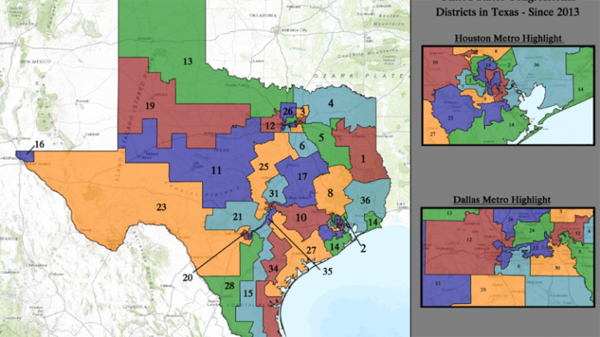- South Texas Students Meet Accordion Music Icons Los Tigres Del Norte In Edinburg Thanks To Khs America/Hohner Alianza Académica Initiative
- Fragile Planet Offers a Nighttime Wildlife Experience
- Falcons Soccer Off & Running
- Cameron County Receives Funds to Improve Two Parks
- Falcons Complete First Half of 32-6A
- School District to Help out Victims of California Wildfires
- Sand Castle Days Continued Despite Unexpected Weather
- Ready for District
- Discussion of Garbage Dumpster Rates, Agreements Between State & City on Highway Regulations, and More
- 31st Annual Shrimp Cook-Off is Right Around the Corner
Plaintiffs Want Texas Congressional Districts Redrawn for 2018
- Updated: April 7, 2017

A federal court recently ruled that Texas Congressional Districts 20, 23 and 27, as drawn in 2011, discriminate against minority voters and violate the Voting Rights Act. Photo: Wikipedia
by Mark Richardson
SAN ANTONIO, Texas – A group of plaintiffs is asking a federal court to force Texas to redraw the state’s current congressional district boundaries ahead of the November 2018 elections.
The three-judge panel ruled March 10 that Republicans had drawn three of the state’s congressional districts with the intent to discriminate against Latino and African-American voters.
Matt Angle, director of the Lone Star Project, a political research group, says the districts identified by the court were “torturously gerrymandered” to exclude minority voters, a process he calls “packing and cracking.”
“Republican leaders drew the maps in which they packed as many of those neighborhoods into as few districts as possible and then they cracked the rest of those neighborhoods into as many districts as possible in order to undermine their voting strength,” he states.
In its ruling, the court did not discuss any remedies to correct the problems. The plaintiffs’ motion seeks to order the Legislature to redraw the state’s current districts in time for the 2018 midterm elections.
Texas Attorney General Ken Paxton maintains that because the ruling pertains only to the 2011 districts, the court has no jurisdiction to order changes in the current boundaries, which went into effect in 2013.
However, Angle says the plaintiffs’ motion points out that when the Legislature redrew the districts in 2013, the three areas the court identified from 2011 were not substantially altered.
“Those districts are absolutely unchanged in the current map relative to the old map, and so you would think that the court would want to change those before we have another election,” he stresses.
The judges found that the three voided districts were drawn to minimize the impact of minority voters, particularly in Austin and San Antonio. He said one district, the 23rd, sprawls 500 miles from San Antonio to near El Paso, an area larger than many states.
“Current Republican leaders see the method for retaining their power long-term to intentionally discriminate against African-American and Latino voters, and the court has stepped in here to call them on the violations,” Angle maintains.
Plaintiffs in the case include the NAACP, Mexican American Legislative Caucus, League of United Latin American Citizens (LULAC), the Texas Latino Redistricting Task Force and several African-American and Latino members of Congress.
